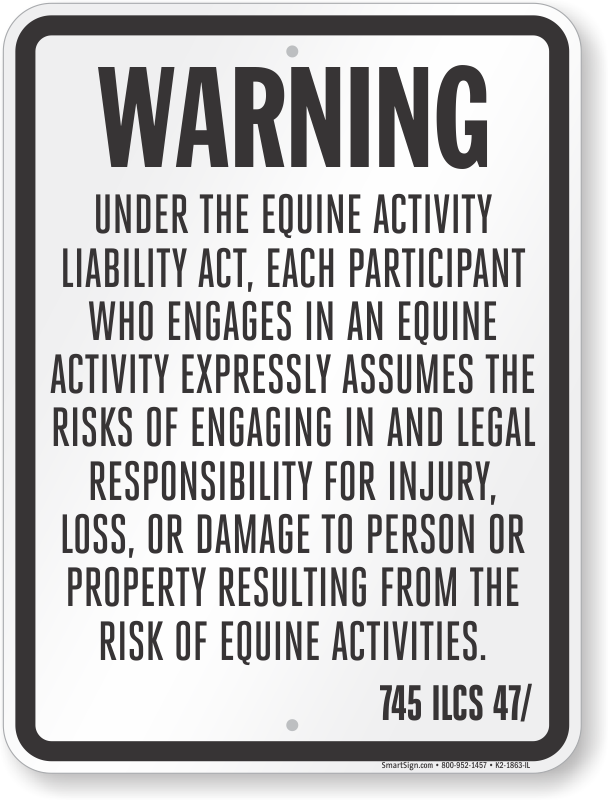 In past articles, we have taken a general look at Equine Activity Liability Laws and how they are intended to operate. As an equine attorney, I would estimate that at least half of the questions people ask have to do in some way with Equine Activity Liability Laws. Consequently, in the next few articles, I’d like to take a closer look at some of the more common issues that arise in that regard.
In past articles, we have taken a general look at Equine Activity Liability Laws and how they are intended to operate. As an equine attorney, I would estimate that at least half of the questions people ask have to do in some way with Equine Activity Liability Laws. Consequently, in the next few articles, I’d like to take a closer look at some of the more common issues that arise in that regard.
As of May 2016, 47 states (all but California, Maryland and New York) had some form of Equine Activity Liability Law (“EALL”) in place. These laws were designed and intended to “simplify” legal issues pertaining to equine activity by limiting the potential liability of those sponsoring equine events and activities. Unfortunately, though, they seem to have had the opposite effect. While most EALLs have many common characteristics, they also have many differences. This has caused a lot of confusion among both sponsors of and participants in equine events, and has resulted in a number of cases in different states arriving at seemingly contradictory conclusions. The reason is that, while all EALLs have the same purpose in mind, each state’s EALL differs as to the details and, as the old adage goes, the devil is in the details.
The four main issues that, in my estimate, most often lead to litigation are as follows:
- How is a “participant” defined?
- What constitutes a “sponsor” or “equine professional?”
- What, exactly, is an “inherent risk” relating to an equine activity?
- What exceptions apply which allow a participant to avoid the effect of the EALLs?
For the purposes of this article, we will focus on the first issue, namely, what constitutes a “participant” to which the EALLs apply?
Picture this scenario: Little Johnny accompanies his mom to XYZ Barn while his mom takes her weekly riding lesson. Johnny is told to sit on the bench by the side of the barn and play his video game while his mom takes her lesson. One of the barn’s employees is nearby just in case Johnny needs something. Johnny’s game runs out of battery and he gets bored. He wanders into the barn while the employee is not looking and gets bitten by a horse. Johnny’s mom wants to sue XYZ Barn for Johnny’s injuries, alleging that he was not a “participant” within the meaning of the law since he was just a visitor. Is Johnny’s mom right? Can she sue?
The answer is … it depends. Each state defines a “participant” differently, some more stringently than others. Here are a few examples:
 In New Jersey, the EALL definition of “participant” includes those accompanying another person who is partaking in an equine activity, even if that person is a minor, or does not actively engage in an activity involving horses (for example, Kirkpatrick v. Hidden View Farms, 2017, in which a child visitor entered a barn where his mother kept her horse and was bitten by another horse).
In New Jersey, the EALL definition of “participant” includes those accompanying another person who is partaking in an equine activity, even if that person is a minor, or does not actively engage in an activity involving horses (for example, Kirkpatrick v. Hidden View Farms, 2017, in which a child visitor entered a barn where his mother kept her horse and was bitten by another horse).
This is also true in Michigan, which has found that a person who is visiting an equine facility for any reason falls within the definition of a “participant” (for example, Amburgey v. Sauder, 1999, where visitors touring an equine facility were considered participants within the meaning of Michigan’s EALL).
Similarly, in Ohio, the EALL definition of “participant” was found to include “spectators,” i.e. those watching any type of equine activity whether as part of an audience or individually, where included within the definition of “participant” (for example, Smith v. Landfair, 2012, where a daughter who watched from a barn door as her father exercised a horse, was kicked by another horse being unloaded from a trailer).
On the other end of the spectrum, in Wisconsin, the EALL has been found to apply only to a person who had actual control of a horse (Hellen v. Hellen, 2013, where a woman who had hold of a lead rope while another was working with the horse was deemed to be a “participant” because she was in control of the horse) Similarly, in Texas, a person who was leading a stallion and was subsequently bitten was deemed a “participant” within the definition of Texas’s EALL, regardless of the purpose for which he was leading the horse (Johnson v. Smith, 2002).
Iowa took this view one step further, indicating that even holding the lead rope was not necessarily enough to constitute “control,” but rather it depended upon the purpose of the activity (Bothell v. Two Point Acres, 1998, where an individual who was injured while leading a horse out to the pasture to graze was not considered a “participant in an equine activity”).
This hotbed issue of who is considered a “participant” also arises quite often in connection with horse auctions. Often, curiosity seekers and those who go along with potential buyers to help and advise them, will allege that, technically, they are not participants because they are not actively bidding or intending to purchase a horse. In this situation, Courts in the majority of states have found that a person attending an auction is a “participant” if that person engaged in any type of interaction with the auction sellers, even if they had no intention of bidding on or purchasing a horse. This is especially true in states whose EALLs find that a “spectator” falls within the definition of “participant.”
Another unique situation in which the question of who is a “participant” has created conflict pertains to horse-drawn carriages. What if a passenger on one of those rides is injured? Again, the Courts cannot seem to agree on this one. Some Courts (most commonly the one’s whose EALLs include even visitors and spectators as “participants”) have held that a passenger on a carriage ride is a “participant.” Other Courts have held that, since the passengers are not in control of the horse, they are not considered “participants” within the definition of the EALL.
If all this sounds just a bit confusing, you’re right. The take-away from all this, though, is clear. If you are intending to participate in any type of equine activity, or if you intend to simply be present in an area where equine activity is taking place, you need to know what the law of the state you are in provides. This way, you will know what your rights, risks and responsibilities are. You can look up any state’s EALL online by going to the website for the American Equestrian Alliance and clicking on their link for “Research: Equine Liability Statutes by State.”
Mati Jarve is the managing partner of the Marlton, New Jersey law firm of Jarve Kaplan Granato, LLC. He is certified by the New Jersey Supreme Court as a Civil Trial Attorney and the National Board of Trial Attorneys as a Trial Advocate. Licensed in New Jersey, Pennsylvania and Arizona, he maintains a national practice in civil litigation, including equine related issues. This article is for informational purposes only and is not intended to be legal advice.
If you have a specific legal question or problem you should consult with an experienced and knowledgeable equine law attorney. Questions, comments or suggestions can be e-mailed to mjarve@nj-triallawyers.com, by visiting www.nj-triallawyers.com.



You must be logged in to post a comment Login